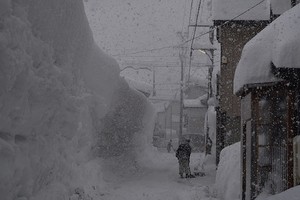By HIDEMASA YOSHIZAWA/ Staff Writer
March 16, 2022 at 17:32 JST
Shock waves triggered by a massive underwater volcanic eruption near Tonga on Jan. 15 were apparently responsible for tidal surges seen along Japan’s Pacific coastline, according to experts.
The Japan Meteorological Agency’s study group said in a draft report compiled March 15 that the tidal surges differed from those generated by a strong offshore earthquake.
It noted that disturbances in the atmosphere were detected after the eruption of the Hunga Tonga-Hunga Ha’apai volcano around 1 p.m. on Jan. 15.
The resulting air pressure waves reached near the Honshu main island, about 8,000 kilometers from the volcano, around 8:40 p.m., according to an analysis of images captured by Japan’s Himawari weather satellite.
An approximately 2-hectopascal increase in atmospheric pressure from Tonga toward Japan was also observed around the same time.
Roughly 30 to 60 minutes later, observatories in Japan began detecting changes in tidal levels. The tidal changes occurred three to four hours earlier than the expected arrival time of a typical tsunami generated by an offshore earthquake.
The study group will complete its report based on its analytical observations by the end of this month at the earliest.
Although there is a correlation between the volcanic eruption and the shock waves, the group said it is difficult to predict the extent of tidal changes in Japan. The group stressed the importance of monitoring changes in sea levels at overseas observatories for the time being.
Around 7 p.m. on Jan. 15, the meteorological agency said it did not expect tsunami to hit Japan following the volcanic eruption.
But it issued a tsunami warning and advisory after recording a 1 meter or higher rise in sea levels along the Pacific coast of Japan from late at night through early Jan. 16.




















A peek through the music industry’s curtain at the producers who harnessed social media to help their idols go global.
A series based on diplomatic documents declassified by Japan’s Foreign Ministry
Here is a collection of first-hand accounts by “hibakusha” atomic bomb survivors.
Cooking experts, chefs and others involved in the field of food introduce their special recipes intertwined with their paths in life.
A series about Japanese-Americans and their memories of World War II